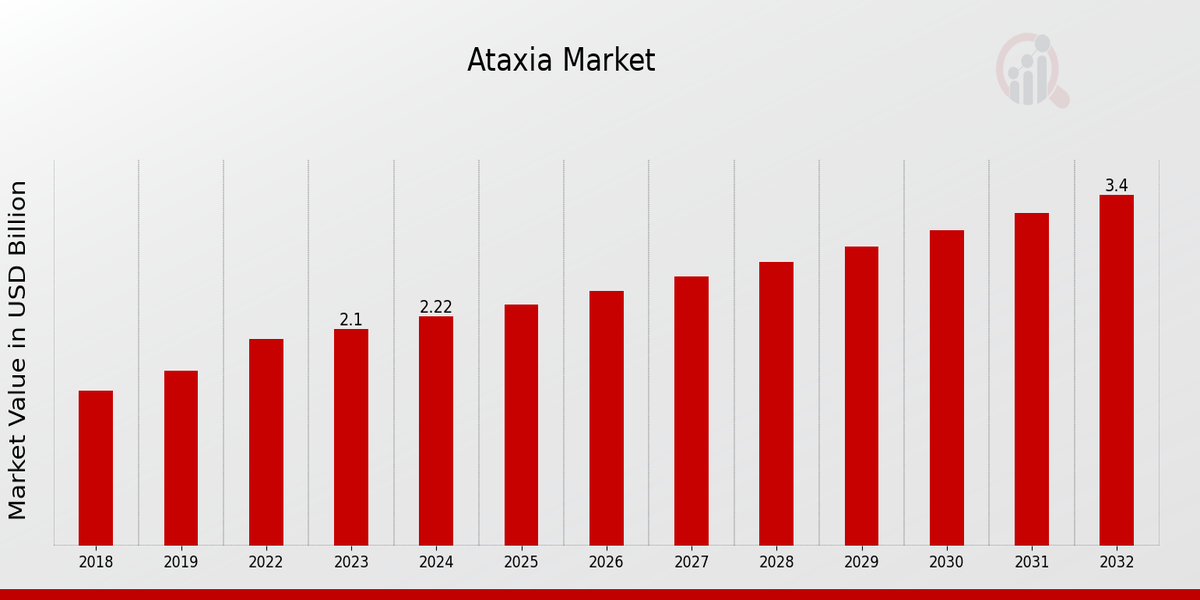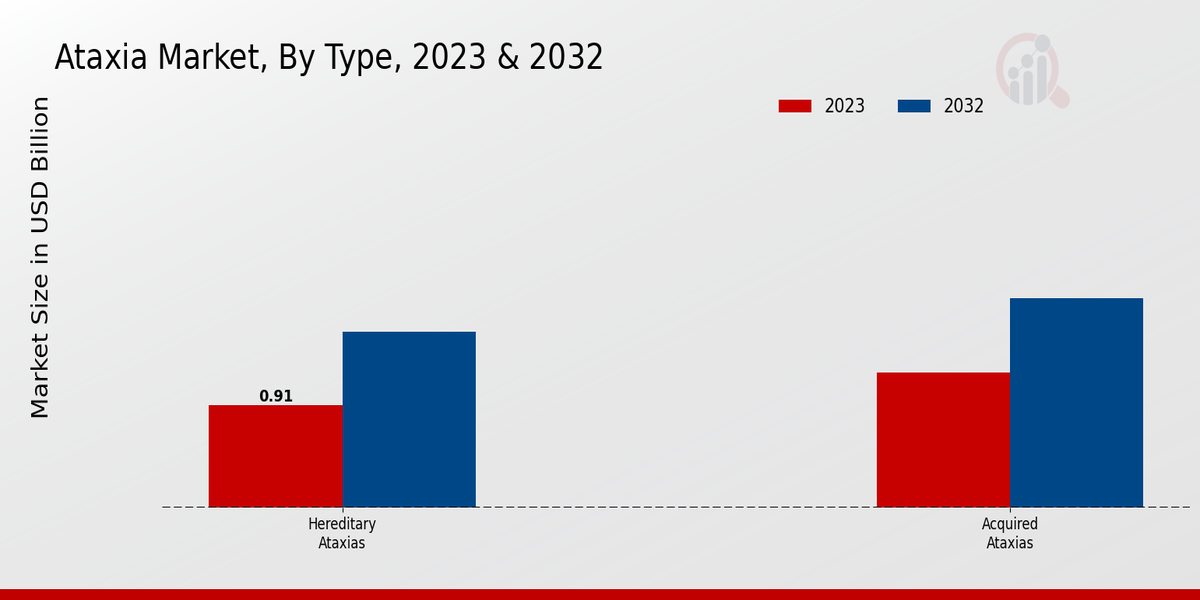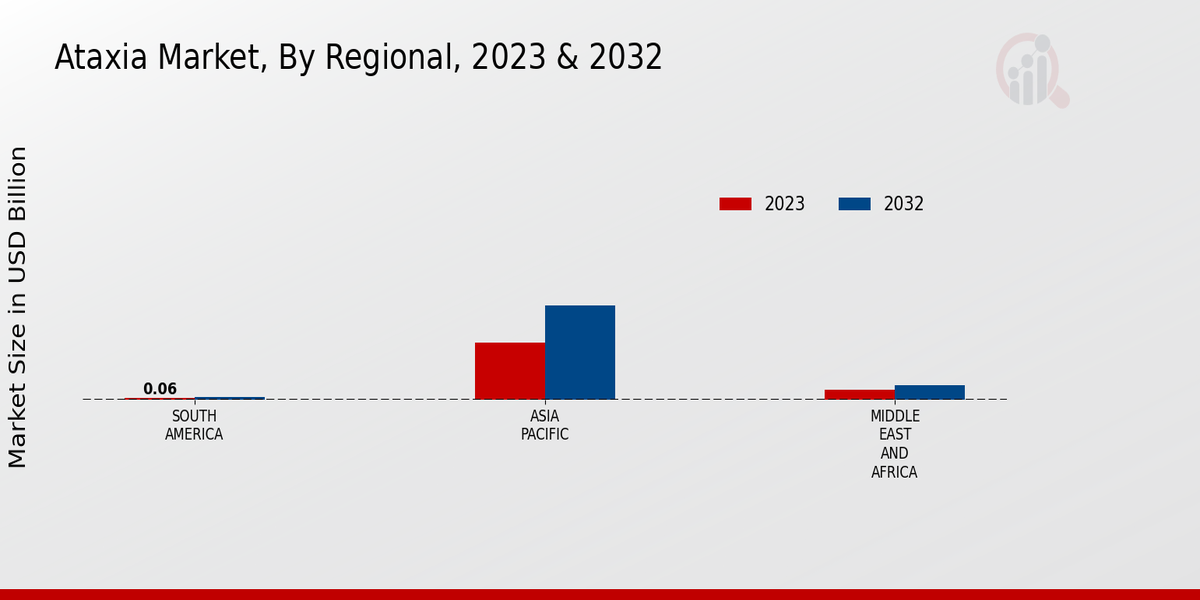Ataxia Market Overview
As per MRFR analysis, the ataxia market size was estimated at 11.53 (USD Billion) in 2023. The ataxia market industry is expected to grow from 12.3 (USD Billion) in 2024 to 19.15 (USD Billion) by 2032. The ataxia market CAGR (growth rate) is expected to be around 5.04% during the forecast period (2024 - 2032).
Key Ataxia Market Trends Highlighted
The global ataxia market is witnessing remarkable growth due to the increasing prevalence of ataxia disorders, advancements in gene therapy and stem cell research, and rising awareness about disease management. The growing demand for minimally invasive and effective treatment options is driving market expansion. Moreover, increasing healthcare expenditure and the presence of supportive government initiatives are contributing to the market's growth.
However, high treatment costs, limited access to specialized healthcare facilities in developing countries, and the challenges associated with developing effective therapies for rare diseases pose challenges to market growth. Despite these challenges, the market is poised to witness significant opportunities with the emergence of personalized medicine, targeted therapies, and the continuous development of innovative treatment approaches.

Source: Primary Research, Secondary Research, MRFR Database and Analyst Review
Ataxia Market Drivers
Technological Advancements in Ataxia Treatment
Advancements in medical technology have led to significant improvements in the diagnosis and treatment of ataxia. These include the development of new genetic testing methods, neuroimaging techniques, and therapeutic interventions. For instance, the use of gene therapy and stem cell therapy holds promise for potential treatments that can target the underlying genetic causes of ataxia.
Additionally, the advent of wearable devices and mobile health technologies has facilitated remote monitoring and personalized care for individuals with ataxia, enabling them to manage their condition more effectively.
Growing Prevalence of Ataxia
The prevalence of ataxia is on the rise, driven by factors such as increasing life expectancy, genetic predisposition, and environmental triggers. The aging population is particularly vulnerable to ataxia, as the risk of neurodegenerative disorders increases with age.
Moreover, genetic research has identified a growing number of genetic mutations associated with ataxia, expanding the understanding of the genetic basis of the condition. These factors contribute to the growing demand for effective treatments and supportive care for individuals with ataxia.
Increasing Awareness and Advocacy
Increased awareness and advocacy efforts have played a crucial role in shaping the global ataxia market. Patient advocacy groups and organizations have been instrumental in raising awareness about ataxia, promoting research, and advocating for policies that support individuals with the condition. This growing awareness has led to increased visibility and recognition of ataxia, resulting in greater demand for specialized healthcare services, support systems, and research funding.
Ataxia Market Segment Insights:
Ataxia Market Type Insights
The global ataxia market segmentation by type comprises Hereditary Ataxias and Acquired Ataxias. Market growth for Hereditary Ataxias is driven by increasing prevalence of genetic disorders, growing awareness of early diagnosis, and advancements in gene therapy.
The acquired ataxias segment holds a larger revenue share due to rising incidence of stroke, traumatic brain injuries, and autoimmune disorders. The market growth is fueled by increasing adoption of rehabilitation therapies, advancements in surgical interventions, and growing demand for personalized treatment options.
Leading industry players are investing in research and development of novel therapies and technologies to cater to the unmet medical needs of patients with ataxia, contributing to the overall market expansion. With the increasing prevalence of neurological disorders and continuous advancements in healthcare infrastructure and technology, the market is anticipated to witness a steady growth trajectory in the coming years. This growth will be driven by increasing demand for specialized treatment options, rising awareness of early diagnosis, and the growing adoption of advanced technologies for disease management.

Source: Primary Research, Secondary Research, MRFR Database and Analyst Review
Ataxia Market Genetic Mutations Insights
TBP gene mutations, ATXN2 gene mutations, and FRDA gene mutations account for a significant portion of the global ataxia market revenue. These genetic mutations lead to impaired motor coordination and balance.
ATXN2 gene mutations, responsible for most cases of Spinocerebellar Ataxia, is also expected to contribute to market growth with a CAGR of 5.8%. FRDA Gene Mutations, known to cause Friedreich's Ataxia, represent another significant segment, expected to grow at a CAGR of 5.9% over the forecast period. The rising prevalence of genetic disorders and the availability of advanced diagnostic techniques are key factors driving the growth of the genetic mutations segment in the global ataxia market.
Ataxia Market Prodromal Symptoms Insights
Prodromal Symptoms: Prodromal symptoms refer to the early, non-specific signs and symptoms that may appear before the onset of ataxia's more recognizable motor symptoms. These symptoms can vary widely and may include:
Oculomotor Apraxia: Difficulty with eye movements, such as trouble initiating or stopping eye movements.
Dysarthria: Speech problems, such as slurred speech or difficulty pronouncing words.
Fatigue: Persistent and overwhelming tiredness.
The presence of prodromal symptoms can be an important indicator of Ataxia's development, allowing for earlier diagnosis and intervention. This growth is attributed to increasing awareness of Ataxia's early signs and symptoms, advancements in diagnostic techniques, and the development of novel therapies targeting prodromal symptoms.
Ataxia Market Severity Insights
The severity segment plays a critical role in the global ataxia market segmentation. In 2023, the moderate severity segment held the largest market share of around 45%, indicating the prominence of individuals experiencing moderate symptoms and functional impairments associated with ataxia.
The mild severity segment is projected to exhibit a steady growth rate during the forecast period, owing to the increasing awareness and early diagnosis of ataxia. Meanwhile, the severe severity segment is expected to witness a significant market share due to the rising prevalence of advanced cases and the need for specialized care and management strategies.
These insights are crucial for market players to understand the varying needs of patients and develop targeted therapies and interventions that address the specific challenges associated with each severity level.
Ataxia Market Treatment Modality Insights
The global ataxia market is segmented based on treatment modality into pharmaceutical therapies, physical and occupational therapy, and lifestyle modifications. Among these segments, pharmaceutical therapies held the largest market share in 2023 and is expected to continue its dominance throughout the forecast period.
The growth of this segment can be attributed to the increasing adoption of disease-modifying therapies and symptomatic treatments for ataxia. Physical and Occupational Therapy is another significant segment, owing to the rising demand for rehabilitation services to improve motor skills and coordination in patients with ataxia.
Lifestyle modifications, such as exercise, dietary changes, and stress management, are also gaining traction as complementary treatments to manage the symptoms of ataxia. The Global Ataxia Market revenue is projected to reach USD 19.15 billion by 2032, expanding at a CAGR of 5.04% during the forecast period.
Ataxia Market Regional Insights
Regionally, North America is anticipated to hold the largest market share, owing to the presence of well-established healthcare infrastructure, high prevalence of ataxia, and government initiatives to support research and development in this field.
Europe is projected to follow North America in terms of market size, driven by increasing awareness about ataxia and the availability of advanced treatment options. The APAC region is anticipated to witness significant growth in the coming years, attributed to the rising geriatric population, increasing healthcare expenditure, and growing awareness about ataxia.
South America and the Middle East and Africa (MEA) are expected to contribute to the overall market growth, albeit at a slower pace, due to limited access to healthcare facilities and low awareness about ataxia in these regions.

Source: Primary Research, Secondary Research, MRFR Database and Analyst Review
Ataxia Market Key Players and Competitive Insights:
Major players are focusing on developing innovative drugs and therapies to address the unmet medical needs of patients with ataxia. Strategic partnerships, acquisitions, and collaborations are common strategies adopted by leading Market players to expand their product portfolio, gain access to new technologies, and strengthen their market position.
The ataxia market is characterized by intense competition, with established players and emerging companies vying for market share. Leading ataxia market players are investing heavily in research and development to stay ahead of the competition and bring new and improved treatments to the market.
The ataxia market development pipeline is robust, with several promising therapies in various stages of clinical development. These therapies have the potential to transform the treatment landscape for ataxia and improve the lives of patients.
Roche is a leading player in the ataxia market with a strong focus on developing innovative therapies for neurological disorders. The company's pipeline includes several promising therapies for ataxia, including gene therapy and antibody-based therapies. Roche has a proven track record of success in developing and commercializing innovative drugs, and it is well-positioned to continue to play a leading role in the Ataxia Market.
Biogen is another major player in the ataxia market with a strong focus on developing therapies for neurodegenerative diseases. The company's pipeline includes several therapies for ataxia, including a gene therapy and an antibody-based therapy. Biogen has a strong track record of success in developing and commercializing innovative drugs, and it is well-positioned to continue to play a leading role in the ataxia market.
Key Companies in the Ataxia Market Include:
- Eli Lilly and Company
- AstraZeneca
- Johnson & Johnson
- Merck & Co.
- Roche
- Biogen
- Sanofi
- Pfizer
- Takeda Pharmaceutical
- GlaxoSmithKline
- Novartis
- Bristol Myers Squibb
- Celgene
- AbbVie
- Amgen
Ataxia Market Developments
The global ataxia market is expected to reach USD 19.15 billion by 2032, exhibiting a CAGR of 5.04% during the forecast period. Increasing prevalence of neurological disorders, growing geriatric population, and rising awareness about ataxia are the major factors driving market growth. Technological advancements in diagnostics and therapeutics, along with government initiatives to support research and development, are further propelling market expansion.
Key players in the market include Biogen, Roche, and Pfizer, among others. Recent news developments include the launch of new drugs such as Xenpozyme by BioMarin Pharmaceutical and the initiation of clinical trials for gene therapy approaches by companies like Regenxbio. These developments indicate a promising future for the ataxia market as it strives to address the unmet medical needs of patients.
Ataxia Market Segmentation Insights
Ataxia Market Type Outlook
- Hereditary Ataxias
- Acquired Ataxias
Ataxia Market Genetic Mutations Outlook
- TBP Gene Mutations
- ATXN2 Gene Mutations
- FRDA Gene Mutations
Ataxia Market Prodromal Symptoms Outlook
- Oculomotor Apraxia
- Dysarthria
- Fatigue
Ataxia Market Severity Outlook
Ataxia Market Treatment Modality Outlook
- Pharmaceutical Therapies
- Physical and Occupational Therapy
- Lifestyle Modifications
Ataxia Market Regional Outlook
- North America
- Europe
- South America
- Asia Pacific
- Middle East and Africa
| Report Attribute/Metric |
Details |
| Market Size 2023 |
11.53(USD Billion) |
| Market Size 2024 |
12.3(USD Billion) |
| Market Size 2032 |
19.15(USD Billion) |
| Compound Annual Growth Rate (CAGR) |
5.04% (2024-2032) |
| Report Coverage |
Revenue Forecast, Competitive Landscape, Growth Factors, and Trends |
| Base Year |
2023 |
| Market Forecast Period |
2024-2032 |
| Historical Data |
2019-2023 |
| Market Forecast Units |
USD Billion |
| Key Companies Profiled |
Eli Lilly and Company, AstraZeneca, Johnson & Johnson, Merck & Co., Roche, Biogen, Sanofi, Pfizer, Takeda Pharmaceutical, GlaxoSmithKline, Novartis, Bristol Myers Squibb, Celgene, AbbVie, Amgen |
| Segments Covered |
Type, Genetic Mutations, Prodromal Symptoms, Severity, Treatment Modality, Region |
| Key Market Opportunities |
1. Cerebellar Transcranial Magnetic Stimulation 2. Gene Therapy Advancements 3. Orphan Drug Designations 4. Wearable Sensor Technologies 5. AI-powered Diagnostics |
| Key Market Dynamics |
1. Increasing prevalence of neurological disorders 2. Growing geriatric population 3. Rising healthcare expenditure 4. Advancements in genetic testing technologies 5. Emerging therapies and treatment options |
| Countries Covered |
North America, Europe, APAC, South America, MEA |
Frequently Asked Questions (FAQ) :
The ataxia market is expected to reach a valuation of 12.3 billion USD in 2024.
The ataxia market is projected to grow at a CAGR of 5.04% from 2023 to 2032.
The ataxia market is expected to reach a valuation of 19.15 billion USD by 2032.
North America is expected to hold the largest market share in the ataxia market, followed by Europe and Asia-Pacific.
The growth of the ataxia market is primarily driven by the increasing prevalence of neurological disorders, growing awareness of Ataxia, and advancements in treatment options.
Major players in the Ataxia market include Biogen, Roche, Novartis, Teva Pharmaceutical Industries, and Merck & Co.
Ataxia can be classified into different types, including Friedreich's Ataxia, Spinocerebellar Ataxia, and Multiple System Atrophy.
Common symptoms of Ataxia include difficulty with coordination, balance, and speech.
Ataxia is diagnosed through a combination of physical examination, family history, and genetic testing.
Treatment options for Ataxia include medications, physical therapy, and speech therapy

















